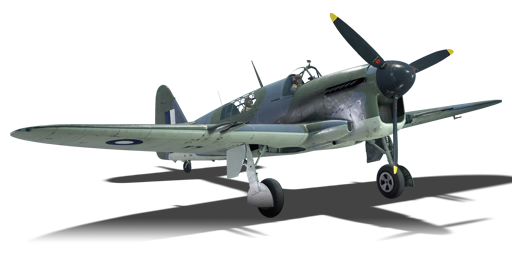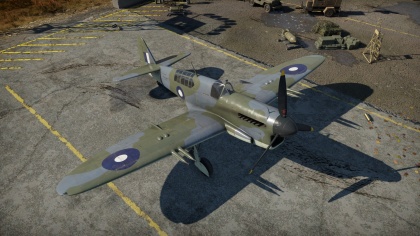Firefly F Mk I
Contents
| This page is about the aircraft Firefly F Mk I. For other uses, see Firefly (Disambiguation) |
Description
The Firefly F Mk I is a Rank III British fighter
with a battle rating of 3.7 (AB), 3.3 (RB), and 4.0 (SB). This aircraft was introduced in Update 1.49 "Weapons of Victory".
Within War Thunder the Firefly F Mk I is a Rank III aircraft situated early on in the Fleet Air Arm line. The distinctive feature of the Firefly Mk I is its characteristic chin radiator that supports the powerful Rolls Royce Griffon engine, later variants of which can also be seen on the late model Spitfire and Seafires. The aircraft is one of the first examples of a 4 cannon fighter aircraft available to pilots and boasts an impressive array of external weaponry to complement this. Thanks to a recent patch update, its 4 x 20mm Hispano Mk II cannons now carry 160 rounds per gun, increasing its total capacity to 640 rounds.
This allows pilots of the Firefly to have more opportunities to attack enemy aircraft or ground targets with its guns. However trigger discipline should still be practiced in order to get the most out of it when it is being operated solely as a fighter. The Firefly can also mount 2 x 250lb, 2 x 500lb or 2 x 1000lb bombs with one under each wing. The final weapon upgrade, HRC Mk 8, allows for the instillation of 8 x 76mm RP-3 rockets, further boosting its ground attack capabilities.
The Firefly often struggles in initial climbing due to the heavy weight and large size of the aircraft. Once engaged however, the Firefly’s “Ace” combat advantage is its exceptional two stage combat flaps. Unlike most aircraft where the flap simply deploys from the wing, the Firefly’s flaps actually swing back to enlarge the wing surface as a whole and create much more lift. This allows it to turn exceptionally well at low speeds without external ordnance attached and makes landings very simple to perform even on carriers. Coupled with a wide track and durable undercarriage, the Firefly rounds off to be a very forgiving aircraft to fly.
General info
Flight Performance
| Characteristics | |||||||
|---|---|---|---|---|---|---|---|
| Stock | |||||||
| Max Speed (km/h at 4,572 m) |
Max altitude (meters) |
Turn time (seconds) |
Rate of climb (meters/second) |
Take-off run (meters) | |||
| AB | RB | AB | RB | AB | RB | ||
| 479 | 470 | 10050 | 22.5 | 23.2 | 10.0 | 10.0 | 480 |
| Upgraded | |||||||
| Max Speed (km/h at 4,572 m) |
Max altitude (meters) | Turn time (seconds) | Rate of climb (meters/second) |
Take-off run (meters) | |||
| AB | RB | AB | RB | AB | RB | ||
| 538 | 508 | 10050 | 19.6 | 21.0 | 18.6 | 12.7 | 480 |
Details
| Features | ||||
|---|---|---|---|---|
| Combat flap | Take-off flap | Landing flap | Air brakes | Arrestor gear |
| ✓ | ✓ | ✓ | X | ✓ |
| Limits | ||||
|---|---|---|---|---|
| Wing-break speed (km/h) |
Gear limit (km/h) |
Combat flap (km/h) |
Max Static G | |
| + | - | |||
| 720 | 270 | 700 | ~9 | ~5 |
| Optimal velocities | |||
|---|---|---|---|
| Ailerons (km/h) |
Rudder (km/h) |
Elevators (km/h) |
Radiator (km/h) |
| < 321 | < 400 | < 410 | > 350 |
| Compressor (RB/SB) | ||
|---|---|---|
| Setting 1 | ||
| Optimal altitude | 100% Engine power | WEP Engine power |
| 1,980 m | 1,510 hp | 1,784 hp |
| Setting 2 | ||
| Optimal altitude | 100% Engine power | WEP Engine power |
| 4,350 m | 1,370 hp | 1,603 hp |
Survivability and armour
- 42.8 mm Bulletproof glass in cockpit front.
- 12.7 mm Steel plate behind the pilot.
- Critical components located at the front of aircraft (fuel, pilot, engine, controls)
- More fuel tanks located in wings near the fuselage
Armaments
Offensive armament
The Firefly F Mk I is armed with:
- 4 x 20 mm Hispano Mk II cannons, wing-mounted (175 rpg outer + 145 rpg inner = 640 total)
Suspended armament
The Firefly F Mk I can be outfitted with the following ordinance:
- Without load
- 2 x 250 lb bombs
- 2 x G.P. 500 lb Mk.IV bombs
- 2 x M.C. 1,000 lb Mk.I bombs
- 8 x 76 mm RP-3 rockets
Usage in the battles
Manual Engine Control
| MEC elements | ||||||
|---|---|---|---|---|---|---|
| Mixer | Pitch | Radiator | Supercharger | Turbocharger | ||
| Oil | Water | Type | ||||
| Controllable | Controllable | Not controllable | Controllable | Combined | Controllable | Not controllable |
Modules
| Tier | Flight performance | Survivability | Weaponry | ||
|---|---|---|---|---|---|
| I | Fuselage Repair | Radiator | |||
| II | Compressor | Airframe | |||
| III | Wings Repair | Engine | |||
| IV | Engine Injection | Cover | |||
Pros and cons
Pros:
- 4 x 20mm Hispano cannons as its armament.
- Reasonably manoeuvrable.
- Heavy bomb loads (up to 2x 1000lbs).
- Exceptionally large flaps grants the plane the ability to fly at unusually low speeds and still be able to manoeuvre.
Cons:
- Rather slow.
- Large target for a single-engine fighter.
- Cannons overheat quickly when stock.
- Lousy climb rate.
- Poor manoeuverability and generally easy prey for other fighters.
History
The Firefly originated as a replacement for both the Blackburn Skua and Fairey Fulmar designs. The tried and tested concept of having two crew, a pilot and an observer, proved to be effective for long range missions where the aircraft would be airborne for an extended period of time. However, the origins of this crew composition were far less well thought out as some of its other features; the late inter-war period saw the British Admiralty insist on two crew members for any naval aircraft other than those intended for point defence, as it was felt that the complexities of over-sea navigation were too complicated for a pilot to carry out whilst simultaneously controlling the aircraft. This would however limit the performance of the aircraft due to the extra weight and size. First taking to the skies in 1941, the Firefly had an impressive 4 x 20mm cannons; a massive improvement over the Fulmar’s 8 x 0.303 inch (7.7mm) Browning Machine guns. The first model was to use a Rolls Royce Griffon IIB engine that was a significant boost over the Fulmar’s Rolls Royce Merlin.
Early on, the Firefly had a rough start before finally reaching naval squadrons in 1943 and becoming fully operational in 1944. As well as taking part on the Tirpitz attacks - providing cover and support - the aircraft mainly served with the British Pacific Fleet. Proving its worth in this theatre of operation, the Firefly continued in service and was refined in later models to greatly improve the performance. Fireflies of the Royal Navy’s Fleet Air Arm would once again see service over the skies of Korea in 1950 alongside Seafires and Sea Furies before finally being retired in 1956 after a lengthy career. The Firefly would also serve with several other navies including the Royal Canadian Navy, Royal Netherlands Navy and Royal Australian Navy to name only a few. The Firefly would ultimately bow out of service well into the age of jets only to be replaced with this new breed of naval aircraft and another Fairey designed aircraft, the Gannet.
Media
An excellent addition to the article will be video guides, as well as screenshots from the game and photos.
Read also
Links to the articles on the War Thunder Wiki that you think will be useful for the reader, for example,
- reference to the series of the aircraft;
- links to approximate analogues of other nations and research trees.
Sources
Paste links to sources and external resources, such as:
- topic on the official game forum;
- page on aircraft encyclopedia;
- other literature.





